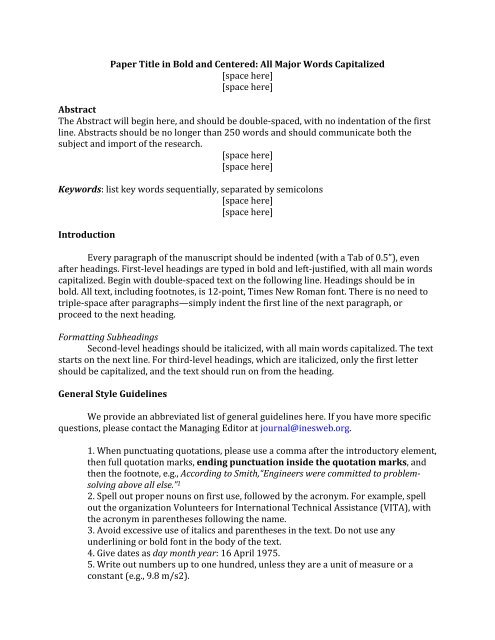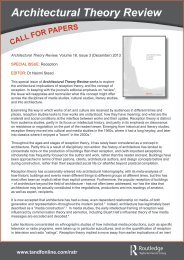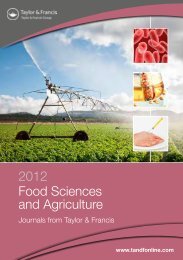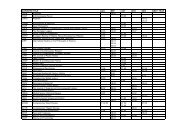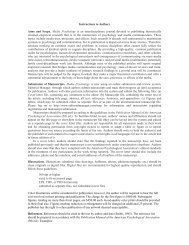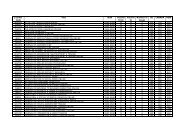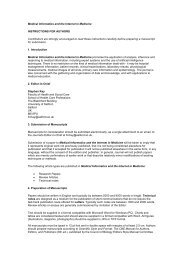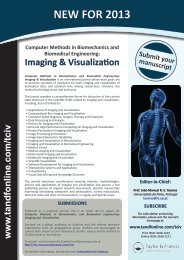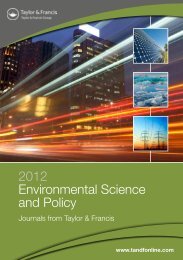Paper Title in Bold and Centered: All Major Words Capitalized ...
Paper Title in Bold and Centered: All Major Words Capitalized ...
Paper Title in Bold and Centered: All Major Words Capitalized ...
Create successful ePaper yourself
Turn your PDF publications into a flip-book with our unique Google optimized e-Paper software.
<strong>Paper</strong> <strong>Title</strong> <strong>in</strong> <strong>Bold</strong> <strong>and</strong> <strong>Centered</strong>: <strong>All</strong> <strong>Major</strong> <strong>Words</strong> <strong>Capitalized</strong> <br />
[space here] <br />
[space here] <br />
Abstract <br />
The Abstract will beg<strong>in</strong> here, <strong>and</strong> should be double-‐spaced, with no <strong>in</strong>dentation of the first <br />
l<strong>in</strong>e. Abstracts should be no longer than 250 words <strong>and</strong> should communicate both the <br />
subject <strong>and</strong> import of the research. <br />
[space here] <br />
[space here] <br />
Keywords: list key words sequentially, separated by semicolons <br />
[space here] <br />
[space here] <br />
Introduction <br />
Every paragraph of the manuscript should be <strong>in</strong>dented (with a Tab of 0.5”), even <br />
after head<strong>in</strong>gs. First-‐level head<strong>in</strong>gs are typed <strong>in</strong> bold <strong>and</strong> left-‐justified, with all ma<strong>in</strong> words <br />
capitalized. Beg<strong>in</strong> with double-‐spaced text on the follow<strong>in</strong>g l<strong>in</strong>e. Head<strong>in</strong>gs should be <strong>in</strong> <br />
bold. <strong>All</strong> text, <strong>in</strong>clud<strong>in</strong>g footnotes, is 12-‐po<strong>in</strong>t, Times New Roman font. There is no need to <br />
triple-‐space after paragraphs—simply <strong>in</strong>dent the first l<strong>in</strong>e of the next paragraph, or <br />
proceed to the next head<strong>in</strong>g. <br />
Formatt<strong>in</strong>g Subhead<strong>in</strong>gs <br />
Second-‐level head<strong>in</strong>gs should be italicized, with all ma<strong>in</strong> words capitalized. The text <br />
starts on the next l<strong>in</strong>e. For third-‐level head<strong>in</strong>gs, which are italicized, only the first letter <br />
should be capitalized, <strong>and</strong> the text should run on from the head<strong>in</strong>g. <br />
General Style Guidel<strong>in</strong>es <br />
We provide an abbreviated list of general guidel<strong>in</strong>es here. If you have more specific <br />
questions, please contact the Manag<strong>in</strong>g Editor at journal@<strong>in</strong>esweb.org. <br />
1. When punctuat<strong>in</strong>g quotations, please use a comma after the <strong>in</strong>troductory element, <br />
then full quotation marks, end<strong>in</strong>g punctuation <strong>in</strong>side the quotation marks, <strong>and</strong> <br />
then the footnote, e.g., Accord<strong>in</strong>g to Smith,“Eng<strong>in</strong>eers were committed to problem-solv<strong>in</strong>g<br />
above all else.” 1 <br />
2. Spell out proper nouns on first use, followed by the acronym. For example, spell <br />
out the organization Volunteers for International Technical Assistance (VITA), with <br />
the acronym <strong>in</strong> parentheses follow<strong>in</strong>g the name. <br />
3. Avoid excessive use of italics <strong>and</strong> parentheses <strong>in</strong> the text. Do not use any <br />
underl<strong>in</strong><strong>in</strong>g or bold font <strong>in</strong> the body of the text. <br />
4. Give dates as day month year: 16 April 1975. <br />
5. Write out numbers up to one hundred, unless they are a unit of measure or a <br />
constant (e.g., 9.8 m/s2).
6. Eng<strong>in</strong>eer<strong>in</strong>g Studies accepts both American <strong>and</strong> British forms of spell<strong>in</strong>g, but we <br />
request that <strong>in</strong>dividual manuscripts be <strong>in</strong>ternally consistent. <br />
7. Italicize words that appear <strong>in</strong> languages other than English. Authors may also <br />
choose to italicize key theoretical concepts or terms, but are encouraged to refra<strong>in</strong> <br />
from do<strong>in</strong>g so excessively. <br />
8. Avoid excessive use of capitals. Proper nouns should be capitalized. <br />
Formatt<strong>in</strong>g Tables <br />
Tables should be numbered <strong>and</strong> titled <strong>in</strong> bold above the table, <strong>and</strong> should list the source <br />
after the table. <br />
[space here] <br />
[space here] <br />
Table 12.13 Wages by Skill Level <strong>and</strong> Nationality, 1971 (Thous<strong>and</strong> CFA Francs per <br />
Month) <br />
H<strong>and</strong>l<strong>in</strong>g Illustrations <br />
<strong>All</strong> illustrations should <strong>in</strong>clude captions. A list of figures should be <strong>in</strong>cluded at the end of <br />
the manuscript. <br />
[space here] <br />
[space here] <br />
Fig. 1.1 This caption would describe the illustration above. <br />
Acknowledgments <br />
Acknowledgments may appear after the ma<strong>in</strong> body of the text <strong>and</strong> before the <br />
References page. Authors should limit their acknowledgments to no more than 150 words. <br />
Acknowledgements should only be added to the manuscript once it has been accepted, <strong>in</strong> <br />
order to keep the manuscript confidential for bl<strong>in</strong>d review.
References <br />
Footnotes <br />
Reference <strong>in</strong>formation should be given <strong>in</strong> a shortened form <strong>in</strong> footnotes, with a full <br />
version given <strong>in</strong> a list of references at the end of the manuscript. Do not use ibid. or op.cit. <br />
Footnotes should be given <strong>in</strong> abbreviated form as Name, Short <strong>Title</strong> (up to a colon only), <br />
year, pages (if po<strong>in</strong>t<strong>in</strong>g to specific pages only). In other words, do not <strong>in</strong>clude page <br />
numbers if cit<strong>in</strong>g an entire article or book chapter. Use semicolons to separate multiple <br />
references with<strong>in</strong> one footnote. For non-‐English titles the orig<strong>in</strong>al language title should go <br />
first, followed by the English translation <strong>in</strong> brackets – <strong>in</strong> both footnotes <strong>and</strong> the reference <br />
list. <br />
Footnote examples for cit<strong>in</strong>g specific pages: <br />
Kranakis, Construct<strong>in</strong>g a Bridge, 1997, p. 34. <br />
Meiks<strong>in</strong>s <strong>and</strong> Smith, “Eng<strong>in</strong>eers <strong>and</strong> Convergence,” 1996, pp. 257-‐258. <br />
Footnote example for cit<strong>in</strong>g entire articles or chapters: <br />
Slaton, “Ambiguous Reform,” 2010. <br />
Footnote example for non-‐English titles: <br />
J<strong>in</strong> <strong>and</strong> Yoon, “Kodŭnghaksaengdŭrŭi igonggye kip'ihyŏnsang silt'aebunsŏk mit <br />
kaesŏnbangan” [Korean High School Students’ Avoidance of Science <strong>and</strong> <br />
Eng<strong>in</strong>eer<strong>in</strong>g <strong>Major</strong>s <strong>in</strong> Colleges <strong>and</strong> Universities], 2002, pp.54-‐71. <br />
Footnote example for cit<strong>in</strong>g websites: <br />
Pritchard, Service Learn<strong>in</strong>g <strong>and</strong> Eng<strong>in</strong>eer<strong>in</strong>g Ethics, 1999. <br />
Reference list <br />
Below are examples for how to cite commonly used sources <strong>in</strong> the reference list. <br />
Editors may ask authors to translate titles that appear <strong>in</strong> languages other than English. If <br />
you need to cite a source that is not listed here, please contact the Manag<strong>in</strong>g Editor at <br />
journal@<strong>in</strong>esweb.org for guidel<strong>in</strong>es. <br />
Book <br />
Edited Book <br />
Kranakis, Eda. Construct<strong>in</strong>g a Bridge: An Exploration of Eng<strong>in</strong>eer<strong>in</strong>g Culture, Design, <br />
<strong>and</strong> Research <strong>in</strong> N<strong>in</strong>eteenth Century France <strong>and</strong> America. Cambridge: The MIT <br />
Press, 1997. <br />
Canel, Annie, Ruth Oldenziel, <strong>and</strong> Kar<strong>in</strong> Zachmann, eds. Cross<strong>in</strong>g Boundaries, <br />
Build<strong>in</strong>g Bridges:Compar<strong>in</strong>g the History of Women Eng<strong>in</strong>eers 1870s -‐ 1990s: <br />
Harwood Academic Publishers, 2000. <br />
Part of a Book <br />
Meiks<strong>in</strong>s, Peter, <strong>and</strong> Chris Smith. "Eng<strong>in</strong>eers <strong>and</strong> Convergence." In Eng<strong>in</strong>eer<strong>in</strong>g
Journal Article <br />
Report <br />
Labour: Technical Workers <strong>in</strong> Comparative Perspective, edited by Peter <br />
Meiks<strong>in</strong>s <strong>and</strong> Chris Smith, 256-‐85. London: Verso, 1996. <br />
Slaton, Amy E. “Ambiguous Reform: Technical Workforce Plann<strong>in</strong>g <strong>and</strong> Ideologies of <br />
Class <strong>and</strong> Race <strong>in</strong> 1960s Chicago.” Eng<strong>in</strong>eer<strong>in</strong>g Studies 2, no. 1 (2010): 5-‐28. <br />
Jo, Donggi. “Chungsanch'ŭngŭi sahoe<strong>in</strong>'guhakchŏk t'ŭksŏnggwa chugwanjŏk<br />
kyech'ŭngŭisik” [Socio-Demographic Characteristics <strong>and</strong> Subjective Class<br />
Consciousness of Korean Middle Class]. Korean Journal of Population Studies 3<br />
(2006): 89-109.<br />
Schmitt, Rol<strong>and</strong> W. "Eng<strong>in</strong>eer<strong>in</strong>g, Eng<strong>in</strong>eers, <strong>and</strong> Eng<strong>in</strong>eer<strong>in</strong>g Education <strong>in</strong> the <br />
Twenty-‐First Century." Belmont, Maryl<strong>and</strong>: National Science Foundation <strong>and</strong> <br />
National Academy of Eng<strong>in</strong>eer<strong>in</strong>g, 1990. <br />
Conference <strong>Paper</strong> <br />
Sheppard, Sheri. D., <strong>and</strong> M. Kathleen Silva. "Descriptions of Eng<strong>in</strong>eer<strong>in</strong>g: Student <strong>and</strong> <br />
Eng<strong>in</strong>eer<strong>in</strong>g Practitioner Perspectives." <strong>Paper</strong> presented at the 31st Annual <br />
Frontiers <strong>in</strong> Education Conference Impact on Eng<strong>in</strong>eer<strong>in</strong>g <strong>and</strong> Science <br />
Education, Reno, NV, United States, 2001. <br />
Orig<strong>in</strong>al Manuscript from Archive <br />
Onl<strong>in</strong>e Source <br />
Dissertation <br />
Perronet, Jean-‐Rodolphe. Mach<strong>in</strong>es pour Faire les Epuisements à la Ttâche. <br />
Manuscript 2383, Archives of the Ecole Nationale des Ponts et Chaussées. <br />
Paris: Ecole Nationale des Ponts et Chaussées, 1752. <br />
Pritchard, Michael. Service Learn<strong>in</strong>g <strong>and</strong> Eng<strong>in</strong>eer<strong>in</strong>g Ethics. Presented at the OEC <br />
International Conference on Ethics <strong>in</strong> Eng<strong>in</strong>eer<strong>in</strong>g <strong>and</strong> Computer Science, <br />
March 1999 <br />
Onl<strong>in</strong>e Ethics Center, National Academy of Eng<strong>in</strong>eer<strong>in</strong>g, 1999. <br />
Accessed October 31, 2008. <br />
Jesiek, Brent. "Between Discipl<strong>in</strong>e <strong>and</strong> Profession: A History of Persistent Instability <br />
<strong>in</strong> the Field of Computer Eng<strong>in</strong>eer<strong>in</strong>g, Circa 1951-‐2006." Unpublished PhD <br />
diss., Virg<strong>in</strong>ia Tech, 2006.


